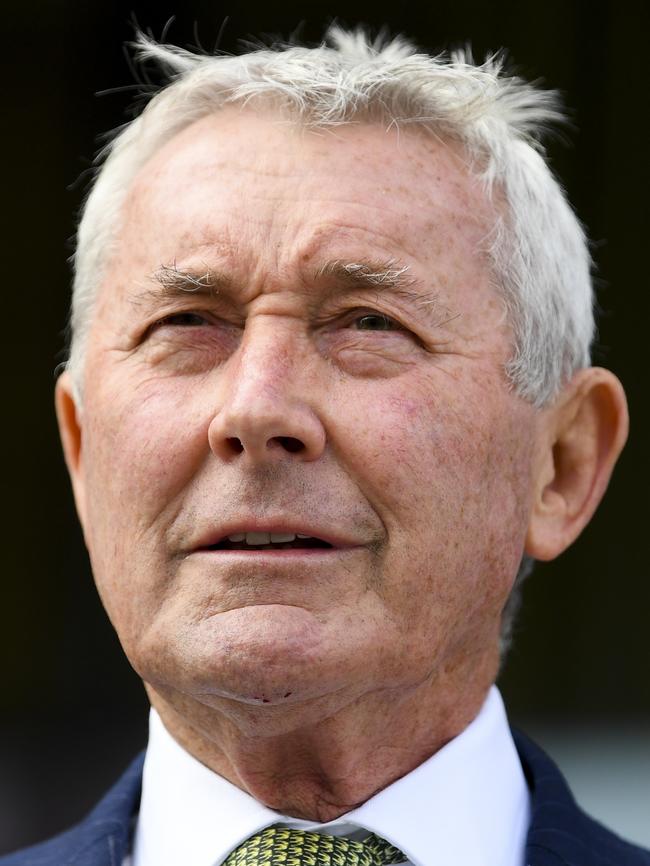Two words – ‘Roger Rogerson’ – change the Whiskey inquest
The killer with a police badge has hovered around the Whiskey story for 50 years.

It took just two words to bring the renewed inquest into the 1973 Whiskey Au Go Go nightclub mass murder in Brisbane to a chilling standstill on Wednesday.
Roger Rogerson.
The name of the former NSW detective and convicted murderer has hovered around the Whiskey story for 50 years. Yes, he says he was rushed up to Brisbane from Sydney immediately after the fire that killed 15 people on March 8, 1973, to lend his investigative expertise to his Queensland police brotherhood.
And yes, he was one of the detectives who interviewed suspect James Finch after the fire – an interview that has been the subject of much speculation. Was Finch verballed? Was he bashed?
But on Wednesday, the whole notion of Rogerson – the killer with a badge – loomed over an inquest approaching its final hour.

A brand new narrative for a very time-worn story was provided to the court, before Coroner Terry Ryan, by the former ACT attorney-general, prosecuted whistleblower and barrister Bernard Collaery.
In the early 1970s, Mr Collaery was working as an investigator in the Special Reports Branch of the Department of Immigration, a clandestine unit created by the federal cabinet to investigate illegal Chinese migration.
He recalled being given a tip-off by an informant prior to the Whiskey tragedy that criminals linked to the Sydney heroin trade were planning to firebomb the Whiskey Au Go Go nightclub while there were people inside.
His informant also mentioned two names that set Mr Collaery on edge: Roger Rogerson and Fred Krahe, a notoriously bent detective who retired from the NSW police force in late 1972 amidst allegations of corruption.
Krahe, some say, was the master, and Rogerson his apprentice.
Tragically, the tip-off and the attack proved to be correct.
Mr Collaery told the coronial inquest that he had raised the warning with Queensland police before the firebombing.
A sex worker informant told Mr Collaery about the recruiting of drug traffickers being done out of the Whiskey and their ability to obtain fake passports.
“The informant produced another young woman who said she had been supplied with a passport to act as a drug mule,” Mr Collaery told the inquest.
“She had been recruited out of (the) Whiskey Au Go Go with the purpose of travelling to Southeast Asia and bringing heroin back into Australia.”
Mr Collaery tracked down the corrupt immigration official behind the passports and grilled him about the operation. The official told the investigator he had heard rumours Sydney’s underworld had grown “jealous” of the operation being supposedly run out of the Whiskey and were plotting to burn the place down.

He intimated the firebombing would not happen while the nightclub was closed but while it was a “going concern”.
The corrupt official also raised the names of Rogerson and Krahe, who were linked to Sydney’s heroin trade.
Mr Collaery said that, after 50 years, he could not remember in what context their names were raised and he could not say they were linked to the fire. His reports from the time were destroyed, but he and his colleagues had suspected the detectives were corrupt.
“Rogerson and Krahe were notorious in those years and my team knew it,” Mr Collaery said.
The warning brought Mr Collaery’s investigative unit “out of the shadows”. He set up a meeting with the head of the Queensland Police Special Branch to tell him about the tip-off.
“I warned my officer in charge that the club would be burned to shut down the club’s recruitment of young female couriers,” Mr Collaery said.
“The thing that made me raise this issue with my boss was that the club wasn’t going to be burnt at night, it was to be burnt as a going concern.
“That’s why we came out of the shadows. I don’t want to dramatise it. It was unusual to come out because, to be quite frank, I didn’t trust the police.”
After the fire, Mr Collaery took a job overseas. He cannot remember being aware that Rogerson was brought in to help on the Whiskey investigation and particularly the rumours that it was linked to the Sydney criminals.

Would it have rung alarm bells if he knew about Rogerson’s secondment, Mr Collaery was asked.
“It would indeed,” he replied.
The story of the Whiskey has been rolling on for half a century and has attracted countless theories along the way – the rumour, gossip, and whispers have swirled around like dust motes.
Was organised heroin importation a thing in 1973?
Was it true that Roger Rogerson was sighted in the Brisbane region just days before the Whiskey was torched?
Plus, if Rogerson did play a central role in the Whiskey firebombing, then isn’t the alleged verballing of Finch now cast in a new light?
They swirl and swirl, these fragile pieces of the puzzle.
Roger Caleb Rogerson will appear as a witness before the coronial inquest via video link on Friday afternoon.
One thing, though, is a solid fact: this murderer with a badge has a few questions to answer.





